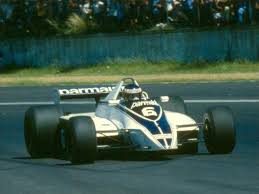kilcoo316 wrote:Tunnels are more antilift than downforce producers.
I'm finding that statement very interesting.
If an isolated ground effect tunnel does not generate much downforce in itself, and instead reduces
the losses from conventional front/rear wings...
Why was
the Lotus 78 so effective?
Its not like
the front or rear wings were mighty aggressive... or
the rear wing was even in
the wake
of the tunnel to influence it (although you could make an argument for
the wingtip vortices).

I can talk about this test freely, as my client is no longer involved in racing and
the head engineer is retired (I was a junior engineer at this time). Though I cannot give you actual downforce/ride change numbers (I don't have them).
This test primarily was geared at understanding tunnels and how to increase efficency in them and we did things outside
of the rules for reasons
of discovery on a full size car, with an non moving ground plane, though
the wheels were spun. 150 mph wind.
We sealed
the tunnels on
the outside to
the ground (ALA
the Lotus,though not moveable as it wasn't a moving ground plane), turned out this was
the largest increase in
the downforce package. and we added strakes inside
the tunnels, seperating
the tunnel into channels. First into two channels, then three. Adding four, five...created no improvement, though one and two added measurable gains.
Lastly in this portion
of the test, we removed
the strakes and added an inboard sealing plane to
the ground, sealing
the tunnel from
the chassis floor, rendering
the tunnel on it's own merit. This changed
the ride numbers by a large amount (lessening
the downward forces on
the whole car by just over half) and increased
the amount
of high pressure areas (literally 10 times
the number
of HPressure pockets) under
the chassis floor.
We then shortened
the inboard "sealer", half way from ground level though still below
the floor. This only provided a small change and increase to efficency.
The high pressure areas (under chassis) were still numerous, though were lessened in pressure readings, though still high pressure; it was only when this "sealer" was put at chassis level, that "most"
of the numbers returned. Removal
of the inboard sealer, allowing
the tunnels full access to
the underbody netted most
of the high pressure under
the chassis disappearing and
the downward forces at full strength.
Our discovery was that
the dispelling
of the high pressure areas (coming from other parts
of the car and entering under
the car), rendered
the tunnel most effective.
The removal
of the high pressure pockets that exist undercar gave a highly effective downforce package and reduction in drag.
One other interesting point, is that
the tunnels had very little pitch senstivity when sealed from both sides
of it, and
the senstivity returned on removal/shortening
of the inboard sealer.
Removal
of the outboard sealer, greatly dropped all
the numbers and literally doubled all
the pitch sensivity numbers.
The center
of pressure movement inside
the tunnel became critical to force distribution and appeared mostly effected by pitch, significantly less in roll only. Seemed that when pitch became involved at any point
the CP numbers greatly effected efficency in long movement rather than lateral. It was summarized/theorized that
the bottom
of the chassis rake movements "allowed" higher numbers
of high pressure areas to accumlate, and only
the areas where
the tunnels were closest to
the ground, were they being removed rather than added.
Lastly,
the removal
of the front wings or flattening
of them, greatly reduced
the number
of high pressure area accumulation (wake and unintended vortices), in turn rendering
the tunnel more effective in removal and reducing front pitch sensitivity and 50% reduction in
the front wing drag numbers (wing removal) Though front wheel turbulance intervention increased. Though over all
the downforce package suffered when
the wings were removed instead
of flattened, also by rather large numbers.
It not so much what happens inside
the tunnel that is so high in
importance. It's how
the surrounding areas (front and sides
of the tunnels) are effected in giving strength to
the aero package. Basically removal or scavenging
of high pressure areas created by other parts/compartments
of the car that
the gains are made in efficency and
the downforce is created, not
the device itself creating it.
Isn't is anti-lift production and not a product
of downforce, but rather allowing
the downforce producing elements (namely wings) or
the higher pressure upper body panels parts (down ward forces) to have further strength. no?
"Driving a car as fast as possible (in a race) is all about maintaining the highest possible acceleration level in the appropriate direction." Peter Wright,Techical Director, Team Lotus









